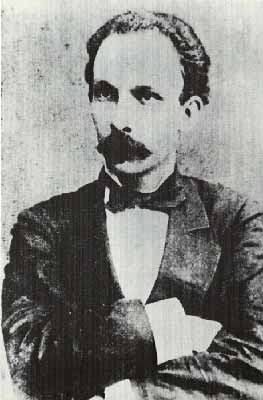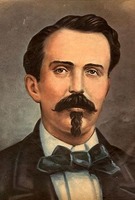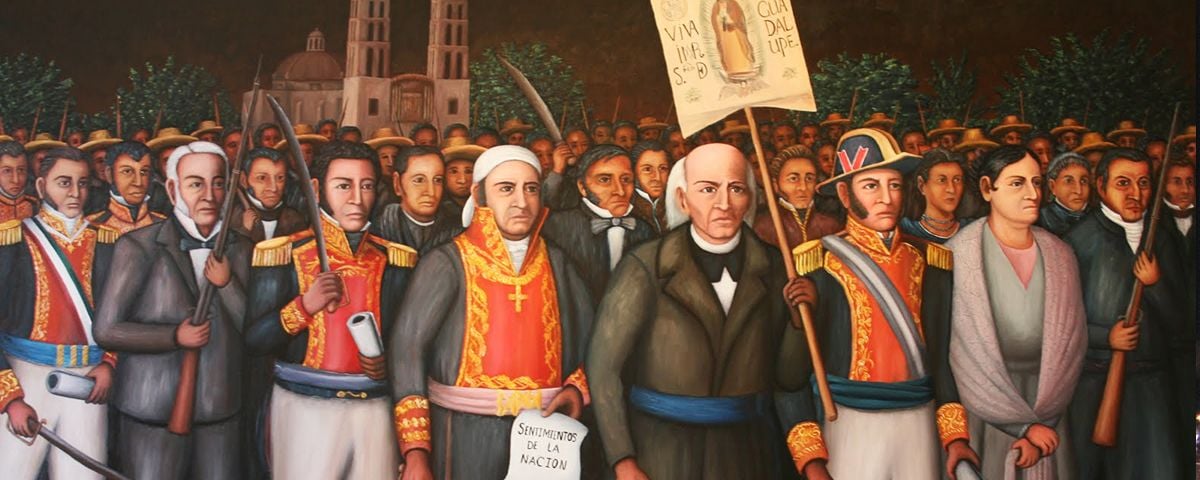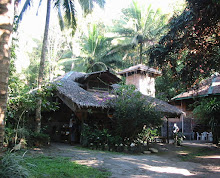November 14, 2018
In 1997 I presented a paper at the 4th AEEP Conference (I think it was the 4th) in Valladolid, Spain. That's the Asociación Española de Estudios del Pacífico. It was a wonderful experience. My paper compared the colonial histories of Filipinas and Chile, and a little bit of Mexican history too, and of our archipelago and the continental mass of the Americas (Nuestra América as José Martí called it).
As you see from the images I posted of O'Higgins, San Martín and Miranda, these were European gentlemen, or they looked the part. They are mestizos, or criollos (born of Spanish parents in the colonies) and had been educated in Europe. So they were born to well-off families. They were white, white enough anyway. Except for Simón Bolívar (accent on the 2nd syllable), who looked mulatto, or was very swarthy.
Hmmm....was he, or wasn't he?
All of them had a more-or-less tragic or difficult end. After the revolutionary wars had been won, the politicans took over, the Masonic Lodges. Oh yeah. This is why it's important to read history. There are patterns! Plus que ca change, plus c'est la meme chose. The more things change, the more they stay the same.
But anyway.......Nuestra América was liberated between 1812 and 1820. Cuba's mambises began their revolution in 1860 (approx.) and didn't win independence until 1898, when Spain and the U.S. signed a treaty in Paris recognizing Cuban independence. BUT the Cubans had to accept the Platt Amendment before the U.S. would withdraw its troops.
The Platt Amendment stipulated the conditions for U.S. intervention in Cuban affairs and permitted the United States to lease or buy lands for the purpose of the establishing naval bases (the main one was Guantánamo Bay) and coaling stations in Cuba.
The Cubans were uninclined to agree, so the Americans said, in that case, prepare for war.
So the cubanos said, okay.
And Fidel Castro had to win Cuba from the U.S. mafia cartels in 1959.
But that was Cuba.
The Cubans pretty much fought on their own, doubtless with some help from volunteers from other Latin American countries. But the wars of independence in Mexico, Venezuela, Colombia, Ecuador, Peru, Argentina, Uruguay (I believe, not sure) and Chile were a coordinated military campaign led by a pretty amazing group of leaders. They had a shared creole and mestizo de español identity. They were more or less from the middle classes or almost aristocratic, such as the Carrera brothers of Chile. José Miguel btw was the most charismatic and in fact became the Director or head of the revolutionary government at just 24 years of age. He was however, a demagogue and what he enjoyed most was organizing barracks uprisings and finally tried to overthrow the revolutionary government. When his star was waning he went to the U.S., attempted to buy arms and find financiers, but failed. The brothers were all executed by the Argentine masonic loggia.
José Miguel Carrera
23 December 2018
I didn't say anything about the comparisons I made between Filipino and Chilean (Latin American) colonial history. Here are just a few points.
- Spanish America was a continental land mass that had already been visited by many Europeans and North Americans (pirates, scientists, merchants) and whose creoles sent their sons to study in Europe (Spain, France, England). The Latin American creoles were a landed aristocracy and a cultured elite who formed a Latin American identity, identification with their American places of birth and differentiation from the Spanish. They finally took the place of the Spanish as the elite founders of the republics. Many of them were Freemasons. Influenced by the North American and French revolutions. But while they had the aspirations of the Age of Enlightenment, they basically took over from the Spanish and at least in the case of Chile, usurpation of Mapuche lands began and the class struggle between the conservative landowners and the peon class, urban worker and middle classes began and continues to this day.
- It was 100 years away from the Age of Neocolonization. So Great Britain, France and the U.S. did not invade militarily. However the U.S. and Great Britain began taking over industries like nitrate production and mining.
- Mexico had a revolutionary process that was begun by 2 secular priests, Hidalgo and Morelos, who were Spanish-Indian mestizos and rallied the deeply religious Indians to free themselves from the yoke of the Spaniards, called "gachupines", under the protection of Our Lady of Guadalupe. The friar orders did not want a repetition of this in Filipinas, even more reason then not to allow secular priests in Filipinas to gain influence over the native population through presiding over the parishes. For this reason also they formed the policy early on not to evangelize in Spanish but in the native languages (above all to keep Filipinos from catching revolutionary fever). In Mexico the Spanish friars could not evangelize in nahuatl, and so they lost ground from the beginning to the Mexican secular priests.
- A brotherhood of creoles who were the aristocracy carried out the revolutions of America. This was why in Filipinas the colonial administration did not want the military or civilian Spanish (especially poor Spaniards) to settle outside Manila, to prevent the formation of a creole and mestizo class who would be more prone to identify with the land and compete for power with them. The Spanish friars were not seen as a danger in this sense but as a guarantee.
- In Filipinas there were too many micro-identities, no creole race formed or Spanish mestizaje of significant number, and there were many racial and religious divisions, Muslims, mountain tribes, Chinese, Chinese mestizos, a large majority of Malays who spoke different languages, most did not speak Spanish, lived in the rural areas, never read anything but religious pamphlets, the influence of the French and American revolutions was effectively blocked by the friar orders. BUT by the 19th century young Filipinos educated in Europe already imbibed the ideas of Liberalism, though they needed to be radicalized by the injustices in their native Filipinas, just intellectual information was not enough. This did happen, as we know.
- Cuba began its revolutionary process around 1869, led by creoles together with blacks and mestizos. Cuba was much smaller than the Philippines in territory and Cuban identity formed earlier---no language differences---, besides which, the island was colonized by Spain earlier as well, in 1509. But it had a difficult and long revolutionary process, which also began (like that of Filipinas) with the demand for representation in the Cortes, the end of slavery and of the tobacco monopoly. José Martí, much more modern than Rizal in that he was a 20th century political leader and journalist who worked for Cuban independence from exile in the U.S. and traveled extensively to Central America to create a new consciousness of Hispanic American identity, was the son of Spanish parents. However Martí had the same mystical spirit and charisma as Rizal. Filipinos ought to read and study "el pensamiento martiano". Many Filipinos in the 1890s watched the Cuban process very closely, and many Cubans emigrated to Filipinas.

- José Martí, el Apostol de Cuba. José Martí was born to poor Spanish immigrant parents in Havana, Cuba, on January 28, 1853. Died 1895 in the first battle with Spanish forces (he led a small contingent of revolutionists who arrived on the island by sea from the United States).
- Cuba's revolutionary process began on December 10, 1868 when creole Cuban lawyer Carlos Manuel de Céspedes, owner of a sugar mill called "La Demajagua" declared that he and his men would fight for the ideals of independence and freedom of the black slaves. El 10 de diciembre de 1868, se sublevó el ingenio azucarero de propiedad del abogado Carlos Manuel de Céspedes, establecimiento denominado “La Demajagua”, donde se manifestaron los ideales independentistas, y antiesclavistas de los revolucionarios. https://www.laguia2000.com/cuba/la-independencia-de-cuba
 Carlos Manuel de Céspedes
Carlos Manuel de Céspedes - The Filipino revolutionary process (versus prior isolated revolts against tribute and abuses) began in 1872 with the executions of GomBurZa, continued by the rise of the ilustrado middle class youth who formed the Propaganda Movement in Spain, and whose first leaders were political exiles and, through his novels and fame as a genius who surpassed the Spanish in erudition, high cultural and scientific achievements, fame, and persecution, Rizal as the paradigmatic Hispanic Filipino. His execution marked the beginning of the armed struggle, led by Bonifacio. But the religious-political-social struggle became fragmented because of the lack of unified identity and the leadership was wrested from urban working class Bonifacio by the upper middle class Cavite principal Emilio Aguinaldo, who later gave Filipinas as a present to the Americans (aguinaldo, precisely).
- Aguinaldo had little ideological and spiritual mystique but was a better military strategist than Bonifacio with the loyalty of the important clans of Cavite. However, he later succumbed to his awe of the mestizo class and of the Americans' new brand of imperial charisma. He made several fatal mistakes because of his ego and small-town mentality: envy of Bonifacio and betrayal of the revolution by ordering the arrest and kangaroo trials of the Bonifacio brothers and their horrendous execution on Mt. Buntis (buntis = pregnant) (the pregnancy that would birth the death of the First Filipino Republic), ordering the assassination of Spanish mestizo Antonio Luna, his best general, and replacing the brilliant patriot Apolinario Mabini for the more glamorous, wealthy cosmopolitan social climber (he wanted a noble title from Spain) Paterno as head of his cabinet. All these internal power struggles and betrayals demoralized the Filipino revolutionary forces, brought mistrust and discouragement to the initially unified social classes, and the elites finally decided that the Americans were their best guarantee for protection of their privileges and new access to political power. Thus, the Filipino revolution was begun by the urban working and middle classes with support from wealthy Hispanic Filipinos (including some Spanish and Chinese and Hispanic Chinese Filipinos) and later the protagonism shifted to mainly elite with rural militias and guerrillas who had support from rural populations (the fighting did not take place in the cities but in the countryside, in hamlets and outside provincial capitals), and little by little lost momentum while the Americans got better at guerrilla warfare and began to demoralize the rural population through concentration camp tactics, slaughter of water buffalo, and genocide. It was already the modern age.
 The Mexican revolutionary process was the most chaotic one because of its proximity to the U.S. and France, and was taken over by caciques (military leaders and dictators). The white-skinned mestizo elite became the owners of the country and the Indian majority their underclass. The revolutionary process continues, and the case of Chiapas is very important, an Indian uprising led by a mestizo teacher (Comandante Marcos) because the land's oil reserves were being exploited and the Indian communities continued in poverty and disenfranchisement. For awhile there was a lot of media coverage but there's been a blackout for approx. a decade now. Mexico is (everybody knows) racked by drug wars. The saying is "Pobre Mexico: tan lejos de Dios, tan cerca de Estados Unidos". Poor Mexico; so far from God, so close to the United States. The U.S. taught Filipinos to despise wetbacks. But the Mexican nation is worthy of our immense respect and admiration. Think Emiliano Zapata and Pancho Villa. They have identity and cultural development: great thinkers and writers and artists. We need to study Mexico.
The Mexican revolutionary process was the most chaotic one because of its proximity to the U.S. and France, and was taken over by caciques (military leaders and dictators). The white-skinned mestizo elite became the owners of the country and the Indian majority their underclass. The revolutionary process continues, and the case of Chiapas is very important, an Indian uprising led by a mestizo teacher (Comandante Marcos) because the land's oil reserves were being exploited and the Indian communities continued in poverty and disenfranchisement. For awhile there was a lot of media coverage but there's been a blackout for approx. a decade now. Mexico is (everybody knows) racked by drug wars. The saying is "Pobre Mexico: tan lejos de Dios, tan cerca de Estados Unidos". Poor Mexico; so far from God, so close to the United States. The U.S. taught Filipinos to despise wetbacks. But the Mexican nation is worthy of our immense respect and admiration. Think Emiliano Zapata and Pancho Villa. They have identity and cultural development: great thinkers and writers and artists. We need to study Mexico. Independencia de Chile 1810 - 1823
Independencia de Chile 1810 - 1823
ttps://es.wikipedia.org/wiki/Independencia_de_Chile
Here you see that Chile is a white republic, and the First Nations (Mapuches of the south) began to be robbed of their lands when the Republic was founded. Of course the dark-haired, non-white-skinned mestizo middle and lower classes are also suckered out of their rightful participation in the country's wealth.
Here you see that Chile is a white republic, and the First Nations (Mapuches of the south) began to be robbed of their lands when the Republic was founded. Of course the dark-haired, non-white-skinned mestizo middle and lower classes are also suckered out of their rightful participation in the country's wealth.
VENEZUELA: 5 de Julio de 1811, Declaración de la Independencia de Venezuela en Caracas.
https://www.actualidad-24.com/2013/06/breve-resumen-independencia-de-Venezuela-resumida.html
ECUADOR: El 10 de agosto del 1809 se recuerda el Primer Grito de la Independencia. La gesta acontecida en Quito permitió librar al país del yugo español.
https://www.facebook.com/notes/jack-a-delgado/resumen-de-la-independencia-de-ecuador-10-de-agosto-de-1809/408622535862982/
ARGENTINA: 1810 - 1820
La Independencia de Argentina fue el período de la historia de este país que comienza el 25 de mayo de 1810, con una rebelión que disuelve el Virreinato del Río de la Plata, y establece en el mismo territorio las Provincias Unidas del Río de la Plata, y concluye con el advenimiento del Período de las Autonomías Provinciales, iniciado con una crisis política que se conoció como La Anarquía del Año XX.
https://www.paxala.com/la-independencia-de-argentina/
BOLIVIA:
Declaración de la independencia de Bolivia
Convocada nuevamente la Asamblea Deliberante en Chuquisaca, el 9 de julio de 1825, y concluida se determinó la completa independencia del Alto Perú, bajo la forma republicana, por soberana de sus hijos. Finalmente, el presidente de la Asamblea José Mariano Serrano, junto a una comisión, redactó el Acta de la Independencia que lleva fecha del 6 de agosto de 1825, en honor a la Batalla de Junín ganada por Bolívar.
https://www.eabolivia.com/dia-de-la-independencia-de-bolivia.html
PERU:
La independencia del Perú fue otro capítulo importante en las guerras de independencia hispanoamericanas. Finalmente en abril 1825 concluye la campaña de Sucre en el Alto Perú, y en noviembre de ése mismo año, México consigue la capitulación del bastión español de San Juan de Ulúa en América del norte, y por último, en enero de 1826, caen los reductos españoles del Callao y Chiloé en América del sur. España renuncia en 1836 a todos sus dominios continentales americanos.


No comments:
Post a Comment